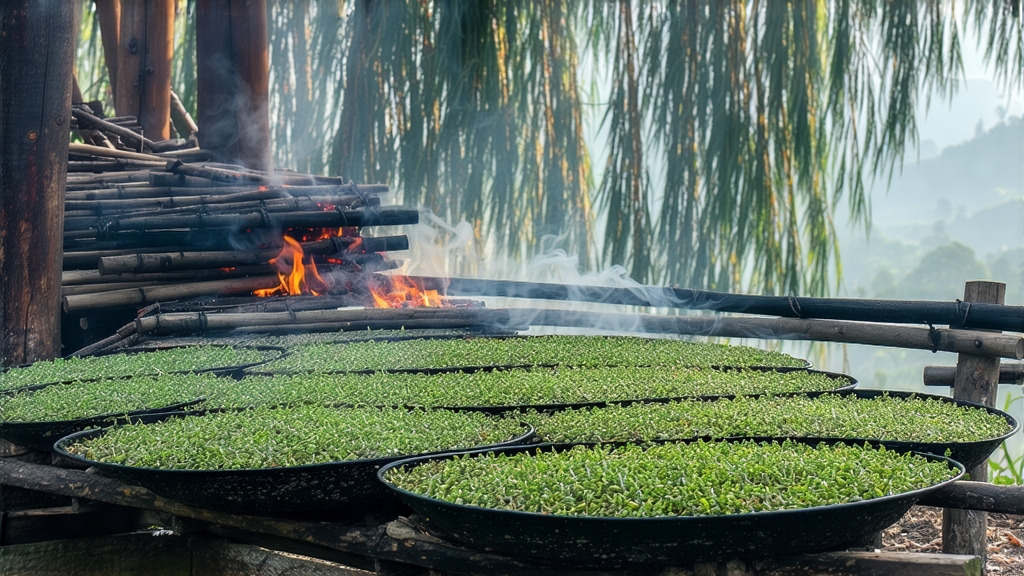
Long before English tea clippers raced across the oceans and Victorian drawing rooms echoed with the clink of porcelain, a small village in the Wuyi Mountains of northern Fujian was already sending the world’s first fully oxidized tea downriver to the port of Xiamen. That tea, called Zhengshan Xiaozhong on Chinese tongues and later baptized Lapsang Souchong by Dutch traders, is the primogenitor of every black tea on Earth. Today, when drinkers from Kolkata to Copenhagen sip malty Assam or brisk Ceylon, they are tasting leaves whose genetic and technological ancestry can be traced back to the pine forests of Tongmu Guan, where smoke, fire, and tea first met.
Historical records kept by the local Xingcun guild show that by 1568—decades before the Dutch East India Company landed its first China cargo—villagers were already bartering “smoked small-leaf” for salt and iron. The name itself encodes geography: zhengshan means “original mountain,” the protected core of the Wuyi UNESCO site; xiaozhong signals the diminutive cultivars that hug the rocky cliffs. When the Kangxi Emperor opened four customs ports in 1684, Lapsang Souchong became the flagship commodity of the “Bohea” trade, a corruption of the local Wuyi pronunciation. By 1800 it commanded twice the price of green tea in London, and Queen Anne allegedly decreed that no other leaf be served at St. James’s Palace. Thus, a Chinese mountain smokehouse unwittingly shaped the morning rituals of an empire on which the sun never set.
Strictly speaking, only leaf picked inside the 60-square-kilometer national reserve may bear the designation Zhengshan Xiaozhong. Outside that boundary, even identical cultivars and technique yield “wai Shan” (off-mountain) tea, a distinction guarded by both geographical indication law and the fierce pride of Tongmu farmers. Within the reserve, three traditional styles survive. Classic Pine-Smoked is crafted from the small, hardy Caicha bushes that root directly into granite fissures; the leaves absorb resinous volatiles for days over smouldering Masson pine. Modern Unsmoked, sometimes sold as “Fruit Aroma” style, omits the final smoking phase, allowing the natural honey and longan sweetness of Wuyi terroir to dominate. A third, increasingly rare, is the Imperial Grade, plucked one-leaf-and-a-bud in early May, then smoked for only two hours so that the ember scent lingers like a distant campfire rather than a tarry cloak. Each style is further subdivided into seven leaf grades, from the wiry, jet-black Superfine down to the broken D grade used in Russian caravan blends.
The craft begins at dawn when the air is still cool enough to lock in aromatics. Pickers climb bamboo ladders lashed to cliffside trees, selecting only the third and fourth leaves—mature enough to withstand the rigorous withering that follows. Back in the village, the leaf is spread on water-polished bamboo trays set over shallow trenches filled with smouldering pine embers. Here, withering and smoking occur simultaneously; the leaf loses 65 % of its moisture while absorbing α-pinene and guaiacol, molecules that will later transmute into the tea’s signature whisky-like nose. Every twenty minutes the trays are rotated so that no leaf scorches, a task judged by the sound: when the rustle turns from a damp whisper to a crisp clack, it is time to roll.
Rolling is still done by foot—an athletic ballet performed on a slanted stone trough. The farmer grips an overhead beam, flexing calf muscles to compress the leaf for exactly 37 minutes, the duration handed down orally for twelve generations. Oxidation follows in cedar-lined chests where the bruised leaf is kept at 26 °C and 80 % humidity for four hours, turning from olive to copper to the color of dried blood. Finally comes the decisive moment: smoking or resting. For classic style, the leaf is laid on wire mesh above a pinewood fire so gentle that only a blue thread of smoke rises. The fire must never flame; flames would volatilize too much resin and leave a harsh, creosote aftertaste. After eight hours the tea is baked over charcoal to fix the aroma, then stone-ground to remove stem and flake